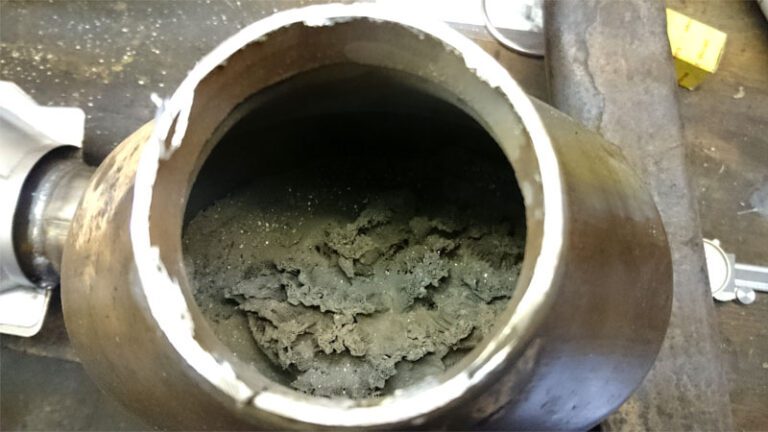How to Blue Exhaust Pipes
To blue exhaust pipes, use a heat-resistant ceramic coating and follow the manufacturer’s application instructions. This process will create a unique and durable blue hue on your exhaust pipes that will withstand high temperatures and add a custom touch to your vehicle.
Are you looking to add a touch of style and customization to your vehicle’s exhaust system? Blue exhaust pipes can provide a distinctive look that sets your vehicle apart on the road. By following a few simple steps, you can achieve this eye-catching blue hue on your exhaust pipes while also protecting them from heat damage.
In this guide, we will explore how you can easily blue your exhaust pipes to give your vehicle a personalized and unique appearance.

Credit: m.youtube.com
Why Blue Exhaust Pipes Are Popular
Blue exhaust pipes have become increasingly popular among car enthusiasts and aftermarket modification aficionados. The distinct blue hue of these pipes adds a unique aesthetic appeal to an automobile, making it a standout feature on the road. But what exactly makes blue exhaust pipes so popular? Let’s delve into the fascinating world of blue exhaust pipes and explore the reasons behind their widespread appeal.
Fascination With Blue Exhaust Pipes
Car enthusiasts are drawn to the mesmerizing blue color emanating from exhaust pipes. It adds a stylish and sporty look to the vehicle, reflecting a sense of individuality and personalization. The allure of blue exhaust pipes goes beyond just the visual aspect – it represents a form of artistic expression and enhanced performance for many automotive enthusiasts.
The Evolution Of Blue Exhaust Pipes
The fascination with blue exhaust pipes has evolved over the years, transitioning from a niche modification to a widely embraced trend. Initially, blue exhaust pipes were primarily associated with high-performance racing cars. However, with advancements in technology and materials, achieving the blue effect has become more accessible, allowing car owners to customize their vehicles with these eye-catching exhaust systems.
Benefits Of Blue Exhaust Pipes
- Enhanced Aesthetics: The distinct blue color of the exhaust pipes adds a visual appeal to the vehicle, garnering attention and admiration on the road.
- Heat Resistance: Blue exhaust pipes are often coated with specialized heat-resistant finishes, ensuring durability and performance under high temperatures.
- Customization: The availability of blue exhaust pipe coatings enables car owners to personalize their vehicles, reflecting their unique style and taste.
- Performance Enhancement: Some enthusiasts believe that blue exhaust pipes signify improved exhaust flow and engine performance, adding a functional aspect to their visual appeal.

Credit: www.amazon.com
Preparing The Exhaust Pipes
To blue exhaust pipes and give your vehicle a unique touch, follow these steps for preparing the exhaust pipes. Achieve a deep blue color that stands out while ensuring a durable finish on your exhaust system.
Thorough Cleaning Of Pipes
Begin by cleaning the exhaust pipes thoroughly to remove any dirt or grime buildup.
Degreasing The Surface
Degrease the surface of the pipes using a suitable degreasing cleaner to ensure a clean starting point.
Sanding The Pipes
Sand the pipes adequately to create a smooth surface for the blue coating to adhere properly.
Choosing The Right High-temperature Paint
Considering Paint Types
High-temperature paint is essential for achieving that vibrant blue hue on your exhaust pipes.
Evaluating Heat Resistance
Ensure the paint can withstand extreme heat to prevent discoloration or peeling.
Finding The Desired Color
Explore a range of shades to find the perfect blue that suits your style.

Credit: www.denniskirk.com
Applying The Paint
When it comes to applying paint to your exhaust pipes, ensuring the proper technique and steps are followed is essential for achieving a professional and long-lasting finish. In this section, we will cover the key steps involved in the process of applying paint to your exhaust pipes, including properly masking the surrounding areas, priming the pipes, and applying the paint in thin coats.
Proper Masking Of Surrounding Areas
Before beginning the painting process, it is crucial to protect the surrounding areas of your vehicle from overspray and potential damage. Properly masking off the adjacent surfaces with masking tape and plastic sheeting will prevent any unintended paint transfer and ensure a clean, professional-looking result.
Priming The Exhaust Pipes
Priming the exhaust pipes is an essential step in preparing the surface for paint adhesion and durability. Applying a high-quality heat-resistant primer specifically designed for metal surfaces will help create a strong bond between the paint and the pipes, ultimately enhancing the longevity of the finish.
Painting In Thin Coats
When it comes to applying the paint, thin coats are the key to achieving a smooth and even finish. Begin by applying a light mist coat, followed by multiple successive thin coats, allowing each coat to dry before applying the next. This method will help prevent drips, runs, and uneven coverage, resulting in a professional-looking finish that will withstand the high temperatures of the exhaust system.
“` In this section, we covered the key steps involved in applying paint to exhaust pipes, including proper masking of surrounding areas, priming the pipes, and painting in thin coats. Following these steps will help you achieve a professional and long-lasting finish for your exhaust pipes.Curing And Maintaining The Blue Finish
To maintain the blue finish on exhaust pipes, start by thoroughly cleaning the surface and removing any rust. Apply a heat-resistant blue paint specifically designed for metals, following the manufacturer’s instructions. After curing, regularly clean the pipes with a gentle soap and water solution to maintain their appearance.
Allowing Sufficient Curing Time
Once you have successfully blue-dyed your exhaust pipes, it is crucial to remember that the curing process is essential to achieve a long-lasting and vibrant finish. Adequate curing time allows the dye to penetrate deep into the metal surface, ensuring color retention and durability. While it may be tempting to rush through this step, patience is key to attaining the desired results.
Bold Note: Ensure you allow sufficient curing time to achieve a vibrant and long-lasting blue finish.
Protective Clear Coat Application
To enhance the durability of the blue finish on your exhaust pipes, applying a protective clear coat is highly recommended. This additional layer acts as a shield against external elements such as heat, moisture, and road debris, preventing the color from fading or peeling off prematurely. The clear coat should be applied after the dye has fully cured, ensuring maximum protection and extending the lifespan of the blue finish.
Bold Note: Apply a protective clear coat for extra durability and to protect against external factors.
Regular Maintenance Practices
Maintaining the blue finish on your exhaust pipes is crucial to ensure its longevity and keep it looking vibrant. Implementing a regular maintenance routine will prevent the accumulation of dirt, debris, and grease, which can dull the blue color over time. Here are some tips to keep your blue exhaust pipes looking their best:
- Regularly clean the pipes using a mild soap or specialized exhaust cleaner.
- Avoid using abrasive scrubbing tools that may damage or scratch the surface.
- Inspect for any signs of chipping or fading and touch up as needed with matching dye and clear coat.
- Consider using heat-resistant wax or polish to add an additional layer of protection.
Bold Note: Implementing regular maintenance practices will keep your blue exhaust pipes looking vibrant and prevent damage.
Frequently Asked Questions For How To Blue Exhaust Pipes
How Do I Make My Exhaust Tip Blue?
To make your exhaust tip blue, use a torch or high heat to heat it up, which causes a chemical reaction with the metal.
Can You Blue A Steel Exhaust?
Yes, you can blue a steel exhaust by heating it to a high temperature to create a thin layer of oxidation for a bluish tint.
What Causes Blue Exhaust Pipes?
Blue exhaust pipes are typically caused by the burning of engine oil or fuel. This can be due to a rich air-fuel mixture or worn-out piston rings, leading to oil entering the combustion chamber. It is important to address this as it may indicate engine issues.
Are Blue Pipes Rich Or Lean?
Blue pipes can indicate either a rich or lean fuel-air mixture. The color solely depends on the specific fuel used.
How Can I Make My Exhaust Pipes Blue?
To achieve blue exhaust pipes, you can use a heat-resistant ceramic coating or wrap them with blue exhaust tape.
What Causes Exhaust Pipes To Turn Blue?
Exhaust pipes turn blue due to the heat generated by the engine, which causes the metal to change color.
Is It Safe To Blue Exhaust Pipes?
Bluing exhaust pipes is safe as long as you use heat-resistant materials and follow proper installation instructions.
Conclusion
In order to give your vehicle a unique and eye-catching look, consider using the blue exhaust pipe method. By following the simple steps outlined you can achieve a stunning finish that will set your car apart. With attention to detail and patience, you’ll be able to create a stylish and personalized touch to your vehicle’s appearance.
So, why wait? Give your exhaust pipes a makeover today!


